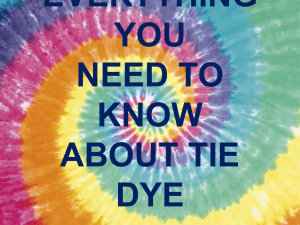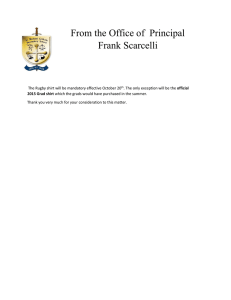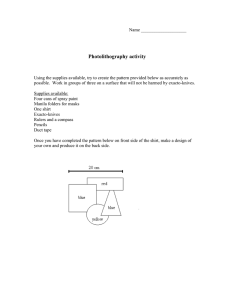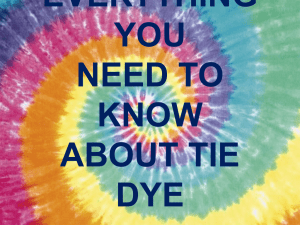GRATEFUL DYEING NAME_______________________________ An introduction to bonding DATE _______________ PERIOD _________
advertisement
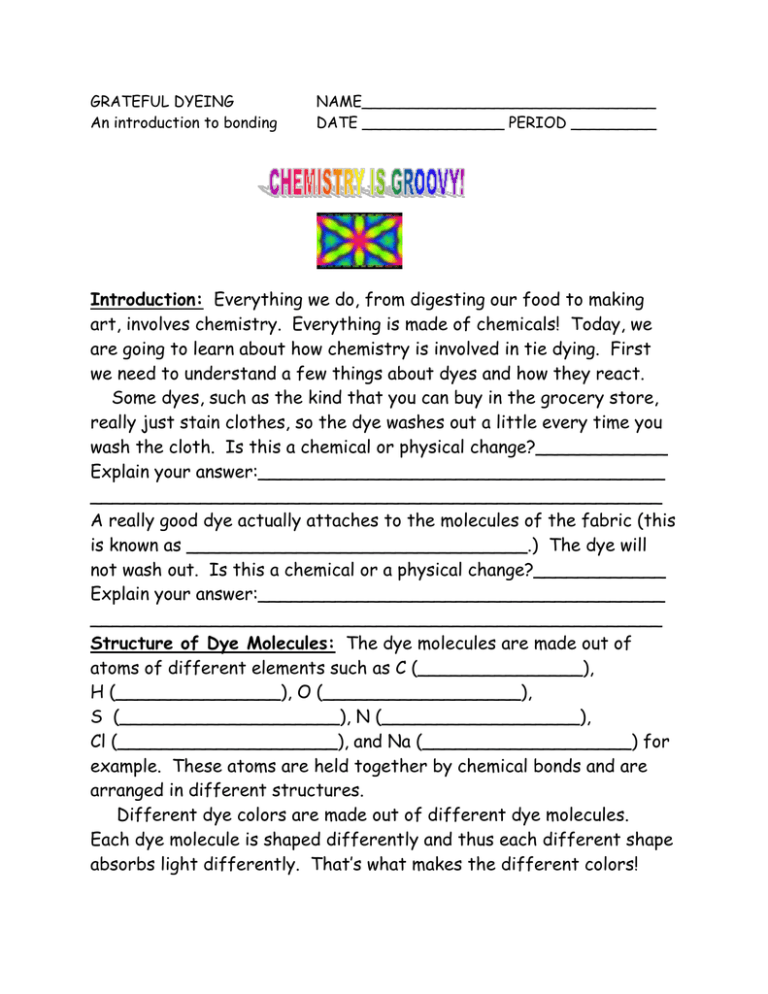
GRATEFUL DYEING An introduction to bonding NAME_______________________________ DATE _______________ PERIOD _________ Introduction: Everything we do, from digesting our food to making art, involves chemistry. Everything is made of chemicals! Today, we are going to learn about how chemistry is involved in tie dying. First we need to understand a few things about dyes and how they react. Some dyes, such as the kind that you can buy in the grocery store, really just stain clothes, so the dye washes out a little every time you wash the cloth. Is this a chemical or physical change?____________ Explain your answer:_____________________________________ ____________________________________________________ A really good dye actually attaches to the molecules of the fabric (this is known as _______________________________.) The dye will not wash out. Is this a chemical or a physical change?____________ Explain your answer:_____________________________________ ____________________________________________________ Structure of Dye Molecules: The dye molecules are made out of atoms of different elements such as C (_______________), H (_______________), O (__________________), S (____________________), N (__________________), Cl (____________________), and Na (___________________) for example. These atoms are held together by chemical bonds and are arranged in different structures. Different dye colors are made out of different dye molecules. Each dye molecule is shaped differently and thus each different shape absorbs light differently. That’s what makes the different colors! See the picture of the molecular structure of the blue and red dyes below. These pictures actually represent __________ of the molecules because molecules are too small to see. Structure of Fabric: The fabric your clothing is made out of is also made of molecules. Cotton, which grows on a cotton plant, is made of large strands of cellulose molecules, all twisted together. Cellulose is the same thing that wood is made of! See picture below: Dye and Fabric Bonding: What we need to do is to prepare the fabric to allow for the bonding of the dye to the cotton. We will add another chemical. A high pH is needed to make the cellulose and the dye react together. So what should we add—an acid or a base?_____________ We will add a chemical called sodium carbonate, Na2CO3 (known as soda ash) which is basic. This will allow the dye to attach to the cellulose permanently by forming a chemical bond. PURPOSE: To reinforce the concept of chemical change and bonding. To learn and experiment with dyes. MATERIALS: - several 5 gallon buckets - urea (H2NCNH2) - soda ash (sodium carbonate) - Procion fiber reactive dyes (many colors) rubber bands large garbage bags disposable latex gloves goggles plastic apron SAFETY AND DISPOSAL: - Soda ash is very basic. You must wear goggles. - Dyes may stain clothing. Do not wear nice clothes to lab. Wear an apron. - Dispose of spilled dye down the sink with plenty of water. - Use a sponge to clean up your mess. SETUP: - The urea water must be prepared 1 day before used to dye. The instructor will take care of this. - Prewash garments that are to be dyed. PROCEDURE: 1. (THIS STEP HAS ALREADY BEEN DONE BY YOUR INSTRUCTOR) Add 750 mL of urea to 4 liters of water and mix well. 1 liter of urea water is needed for each color of dye. Prepare enough for the class. Just before using, mix dyes by adding 4 teaspoons (20mL) dye to 250 mL urea water. 2. Cover the table you will use for dyeing with plastic. You may want to secure to table with tape. 3. (THIS STEP HAS ALREADY BEEN DONE BY YOUR INSTRUCTOR) Prepare the soda ash solution by mixing 1 liter of soda ash (sodium carbonate) to 12 liters of water in a 20 mL bucket. Mark the student shirts. Submerge the garments in the soda ash solution for at least 30 minutes. 4. You must wear goggles and plastic gloves. The tee shirt should be wet but most of the water squeezed out. If too wet, the dye will be diluted. Wring out most of the fixer solution from the shirt into the bucket. The fixer solution can be reused to soak additional tee shirts. . 5. Lay the shirt flat on the clean plastic tabletop. Try to get as many wrinkles out of the shirt. Pick a pattern. Pleat, spiral, or fold the shirt in the desired pattern. See handouts for ideas. 6. Place 2 to 3 long rubber bands around the fabric across the middle to hold the fabric together and the folds in place. The rubber bands should not bind or squeeze the fabric, simply hold everything in place so that it doesn’t unravel. 7. When pouring the dyes from a squirt bottle, be careful when the bottle is tipped. A few drops will squirt out. Hold your gloved finger over the top when tipping. Then apply the dye. 8. Move to the dyeing area. Make sure the area is clean. Place the shirt on the table and begin applying the dyes to the areas desired. Be careful when choosing colors. Orange + blue will turn brown. Suggestions: Don’t put purple next to yellow or orange. This will also turn brown. 9. One thing to pay attention to is the amount of dye added. You want to get enough dye into the shirt so that white spots disappear, but too much dye will cause it to run and mix. Try to balance this. Spread the pleats apart and look. If you see white, add more dye. 10. When done with the front of the shirt, wipe the area clean with a clean sponge and flip the shirt. You can either apply dye to this side matching up the colors from the front or you can apply one color to the whole back. (This is a really neat shirt.) 11. Take a plastic bag and mark your name on it. Spread the bag open and place in the area designated by the teacher. Once the shirt is in the bag, do not move the bag until ready to rinse the shirt out the next day. Place the tee shirt in the bag. Tie the bag with metal twisty. Allow the shirt to sit undisturbed for 24 hours. 12. Wearing gloves and goggles, take the bag to the sink. Remove the shirt. Rinse the shirt with cold water. Squeeze and rinse until no more dye runs from the shirt (This may take 5-10 minutes). Increase the temperature of the water to warm water. Continue to rinse for 5 more minutes. Squeeze shirt dry. Rinse out plastic bag. Place shirt in bag. Take home. Immediately wash the shirt in cold water. Do not wash any other clothes with this shirt the first time. Dry the shirt in the dryer. The shirt is now colorfast and can be washed with dark clothes. Name_________________________________ DATA: SKETCH A DIAGRAM INDICATING THE WAY THE SHIRT WAS FOLDED OR PLEATED: SKETCH A DIAGRAM INDICATING THE WAY THE SHIRT WAS DYED. INDICATE EACH COLOR USED. Draw and color the T-shirt (or object) as it appeared at the end: Name_________________________________ QUESTIONS: 1. Define the following words. Give an example of each. A. CHEMICAL CHANGE: _____________________________________________________________ _____________________________________________________________ Example:_______________________________________________________ B. PHYSICAL CHANGE: _____________________________________________________________ _____________________________________________________________ Example:_______________________________________________________ C. CHEMICAL BOND: _____________________________________________________________ _____________________________________________________________ Example:_______________________________________________________ D. ACID: _____________________________________________________________ _____________________________________________________________ Example:_______________________________________________________ E. BASE: _____________________________________________________________ _____________________________________________________________ Example:_______________________________________________________ 2. What is the chemical formula for soda ash?__________________________ 3. Write the chemical name for the formula above in question 2. _____________ 4. Which of the following could be the pH of the soda ash solution? a. 2 b. 5 c. 7 d. 10 (circle one) 5. Explain your answer to number 4.__________________________________ 6. Explain why the dye does not wash out of the fabric.____________________ ___________________________________________________________
